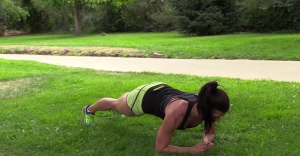Superb Stability Exercises

When I first rolled out on a Fit ball at a fitness convention over 13 years ago, I gained a true understanding of the importance of stability exercises. I rolled this way and that, even landing on my butt once before I got the hang of balancing on the unstable surface.
All the fun tools we use to help accelerate stability training were, at the time, cutting edge. Now they are a normal part of most training programs, but the cool part about our bodies is that you don’t need any equipment at all to help you improve your stability. In fact, starting with the basics and building from there is the best way to improve stability.
Gray Cook, a leading author, coach, and physical therapist in the field of strength and conditioning, reminds us of the importance of stability, which is the successful activation of one muscle coordinated with the successful deactivation of another so you don’t fall over! It sounds simple, but when stabilization reflexes are engaged a complex synergy between timing and motor control takes place.
Your small stabilizing muscles are designed to immediately respond when your body comes out of alignment — you feel this when you step funny and react quickly to catch yourself from tripping or falling. While reactions like this are automatic, stability training becomes the practice of balancing between autopilot and conscious attention.
When you’re first incorporating stability exercises, examine these checkpoints before progressing your movement patterns:
- Mobility – reduce restrictions to avoid compensation and maintain integrity to perform the movement pattern freely.
- Activation – if restrictions are found, assess how you are moving or activating your muscles because of it. Are you overusing a particular muscle group or is it tight and creating an imbalance?
- Foundation – Recommit to rooting yourself into a solid foundation like the ones we use in Yoga in order to deactivate overworked muscles and activate appropriate ones.
The stabilizing muscles consist of small muscle groups found in your shoulder (rotator cuff), core (transverse abdominus), hips and glutes (minimus and medius), and lower legs (stabilizers of the foot and ankle).
Here are five simple stability exercises you can begin to use to assess your current level of timing and motor control. You can then increase it with practice, making all of your movements more fluid, athletic, and functional.
Core stabilization is a necessary component and involves:
- Anterior core stability – to maintain a neutral lumbar curve
- Rotary stability – to prevent hip rotation
- Lateral stability – for balance
5 Exercises for Stability Training:
Perform each exercise for five quality repetitions on each side before any activity to wake up and connect your neuromuscular coordination and proprioception (your sense of positioning and space). Ensure proper form, breath work and engagement throughout.
- Kneeling Bird-Dog with Glute Activation: The bird-dog requires rotary stability throughout to stabilize the hips and torso during the arm and leg movement. The abdominal obliques prevent rotation and also contribute to posterior pelvic tilt, preventing hyperextension of the low back as the leg reaches back.
- Glute Bridge with Single-Leg Abduction: The glute bridge is a fundamental movement for training hip extension. The glute bridge with posterior pelvic tilt (pelvic lift) is often used to treat low back pain and is a great pre-workout exercise that teaches the glute max to function as the primary hip extensor rather than the low back and hamstrings, which is commonly seen. This position is also a great stretch for the hip flexors.
- Rolling-Pin Plank: Core stability is the ability to both resist and control movement. Side plank improves lateral stability while front plank focuses on anterior stability. Both serve in the performance of healthy squat, lunge, and many overhead patterns.
- Half-Kneeling Chops: Narrowing the base in this position calls the stabilizers of the body into action to keep you from falling over. The hips, back, core, and shoulders actively participate in this movement pattern to create stability throughout the range of motion.
- Single-leg Balance Work: the ability to balance and shift weight from one leg to the other occurs in walking, running, climbing stairs, and many more athletic moves — but stability through the ankle, knee and hip during this transition is what prevents injury. Single-leg exercises are by far my favorite form of stability training because no muscle is left out!
Best Tip Ever: “Push down to lift up. Obligate one side to de-obligate the other side.” —Gray Cook
As you go through these exercises, move with intention; listen to what’s happening outside your body and make a change inside your body. Stability exercises enhance your physical control and allow you to accelerate your ability in all endeavors, be it walking the dog or tackling your next mud race.
In Love & Gratitude (for fine tuning your inner athlete),


